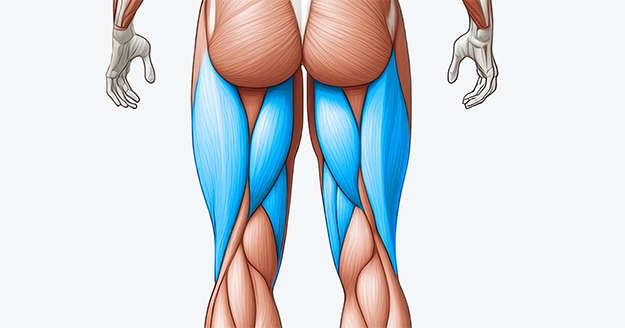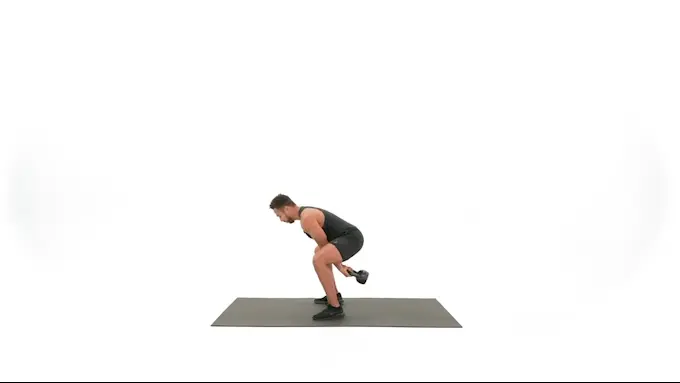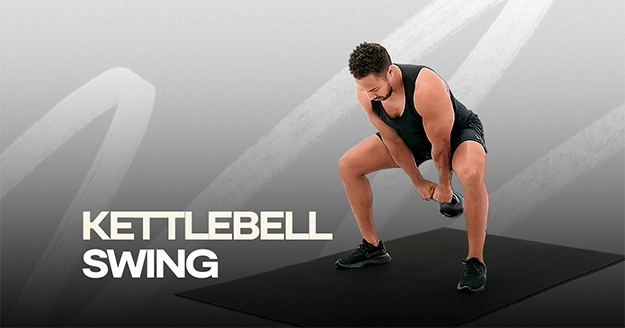Exercise Profile
Kettlebell Swing Overview
The kettlebell swing is a fundamental movement that mainly targets the hamstrings, back, core, and glutes.
It is a practical beginner exercise that teaches the power and coordination required for more complex movements like cleans. Advanced athletes can increase the weight or switch to single-arm swings to further challenge their coordination and overall strength.
The kettlebell swing can be added to your workout routine in several ways, such as for conditioning, building lower body power, or as a functional full-body exercise. This exercise is effective for increasing heart rate and burning calories.

Kettlebell Swing Instructions
Here’s a simple guide on how to do a kettlebell swing.
Step 1: Using both hands, grab a kettlebell with your palms facing you and arms straight down. Stand with your feet slightly wider than hip-width.
Step 2: While inhaling, push your hips back and slightly bend your knees to bring the weight between your legs. Maintain a flat back and a neutral neck while tightening your core and glutes.
Step 3: While exhaling, push through your heels and bring your hips forward while straightening your knees to swing the weight upward. Your arms should remain straight and loose.
Step 4: As the kettlebell begins to descend, inhale and guide the weight between your legs by pushing your hips back and slightly bending your knees.
Step 5: Continue the motion for the desired number of repetitions, maintaining good form throughout.

Common Kettlebell Swing Variations
Kettlebell swings are a dynamic full-body exercise. Mix your routine with different kettlebell swing variations to target specific muscles or increase difficulty. Here are five popular kettlebell swing variations to try:
Kettlebell Swing Tips
- Activate your glutes and core for stability and strength.
- Hinge at the hips during the lowering phase, which will help build up power to perform the movement effectively.
- Keep your arms straight and loose—let the momentum and power from your lower body drive the kettlebell upward, rather than using your arms to lift.
- Exhale as you thrust your hips forward and inhale as the kettlebell comes down. This helps regulate your breath and maintain control during the movement.
Kettlebell Swing Common Mistakes
- Hinging too early: Hinging at the hips too early during the lowering phase of the swing can disrupt the flow of the movement, causing you to lose momentum and control.
- Leaning back: When you lean back, you are overstressing your lower back and not activating your core.
- Squatting instead of hinging: Bending the knees too much and performing a squat-like movement is a common mistake. You won’t get the maximum power you need for the swing.
Frequently Asked Questions
What is a kettlebell swing workout good for?
The kettlebell swing is a great way to burn calories while working your hamstring, back, core, and glutes.
How long should I do kettlebell swings?
To build explosive power, choose a slightly lighter weight—one you can comfortably swing for 3 to 5 sets of 10 to 12 reps.
Can kettlebells give you abs?
Proper kettlebell swing execution is an excellent way to strengthen the muscles in your core.
Who should avoid kettlebell swings?
Kettlebell swings are great for strengthening the lower back, but they must be performed correctly with a proper hip hinge movement. People with herniated discs or other serious back issues should avoid kettlebell swings.
Post your post-workout selfies in IG and tag @trainestapp, #trainest, or DM them to us to get a shoutout on Trainest Stories!


